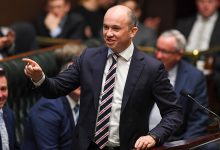The NSW government has claimed a major victory in energy policy, successfully passing legislation implementing its ambitious electricity infrastructure strategy, establishing and enshrining five new renewable energy zones into law.
Kean claimed the passage of the bill – after a marathon 30-hours debate triggered by almost 250 amendments proposed by One Nation – as a ‘historic victory’ and one in which the state had successfully “stared down big energy”.
The legislation is designed to facilitate the construction of up to 12GW of new wind and solar projects, and 2GW of storage capacity, spurring as much as $32 billion in investment over the next decade and replace much of the coal capacity due to retire over the next 10-15 years.
“The passing of the Electricity Bill is a historic victory for the people of NSW. It will deliver thousands of jobs, billions in investment & some of the cheapest reliable energy in the world. It only occurred because Australia’s leading political parties & indies worked together,” Kean tweeted following the passage of the bill.
The passing of the Electricity Bill is a historic victory for the people of NSW. It will deliver thousands of jobs, billions in investment & some of the cheapest reliable energy in the world. It only occurred because Australia’s leading political parties & indies worked together.
— Matt Kean MP (@Matt_KeanMP) November 25, 2020
The legislation establishes arrangements that will allow the NSW government to coordinate investment in new electricity network infrastructure and support the construction of new wind, solar and storage projects.
As part of the plan, the NSW government will be able to provide price guarantees to new projects, establishing a price floor that the government says will help de-risk new project investments and ultimately deliver lower cost energy for consumers.
The NSW government will enter into ‘long-term energy service agreements’ with new projects, awarded through a tender process, that will provide price guarantees to projects that can commit to building new electricity capacity by specified deadlines.
The Berejiklian government’s electricity infrastructure plan has won wide support across the political spectrum, with the NSW Labor opposition, the Greens and most of the crossbench supporting the legislation.
However, “big energy”, in the form of many of the biggest utilities, their peak body, and federal minister Angus Taylor, have attacked the plan. One Nation, led in New South Wales by former federal Labor leader Mark Latham, attempted to delay the passage of the legislation by putting forward 249 amendments to the bill.
Latham’s strategy achieved little besides the delay, with virtually all of One Nation’s amendments being rejected by the parliament and the legislation successfully passing the NSW upper house on Wednesday evening.
The NSW government had initially sought to legislate three previously announced renewable energy zones in the bill, across the Central-West Orana, New England and South West regions of the state.
However, the final legislation includes a total of five renewable energy zones, with the Hunter-Central Coast region and the Illawarra region added through agreed amendments.
Kean had earlier in the week defended the plan from criticism made Taylor who, without referring specifically to the NSW plan, said that he was concerned about state energy policies that could push coal generators into an early retirement.
Kean responded by saying the now legislated plan would do no such thing, but that the government had to act as four of the state’s largest coal fired power stations were expected to close by 2035, and that he stood on the ‘side of the public, not on the side of the vested interests‘ in perusing the state’s ambitious clean energy strategy.
The legislation has been welcomed by a wide range of energy market participants and clean energy advocates, who said the legislation was an example of what can be achieved through cooperation and support across the political spectrum.
“Renewables are the most popular and the most affordable form of new electricity and that truth has clearly been embraced by the NSW Parliament with the Coalition Government, Labor Party, Greens and independents like Alex Greenwich committing to legislation to turn NSW into a renewable energy superpower,” the Australia Institute’s climate and energy program director Richie Merzian said.
“This Renewable Plan shows how cross-party climate policy can work including for the benefit of workers and regional communities.”
The Australian Energy Council which represents some of the largest incumbents within the Australian energy market, toned down its opposition after the passage of the bill, saying it welcomed the passage of the plan, but added that it still preferred an approach to energy policy that was coordinated at a federal level.
“We support the Roadmap’s overall objectives of cleaner, cheaper power,” Australian Energy Council chief executive Sarah McNamara said. “We do remain concerned about its impact on the functioning of an increasingly interconnected National Electricity Market and the complexity it will certainly add to investment decisions.
“We will continue to argue for a national and coordinated approach to energy policy as this is the framework most likely to deliver the best results for customers in NSW and other states and territories – namely reliable, affordable and sustainable electricity supply.”










